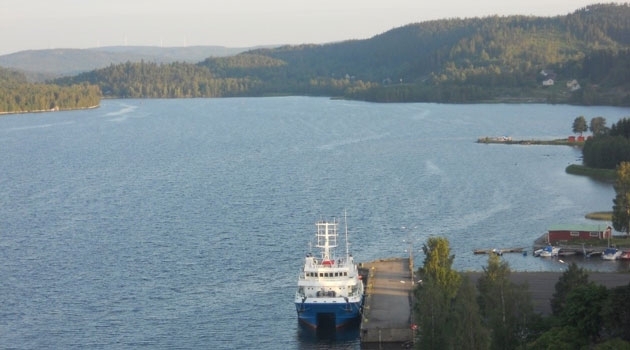New report on environmental toxins along the coast of northern Sweden
During much of the 20th century, the paper and pulp industry released huge amounts of environmental toxins along the coast of northern Sweden, and these toxins collected in what is known as fibre banks. Fibre banks contain organic environmental pollutants and metals, sometimes in very high amounts. An interdisciplinary research team has studied the fibre banks along Ångerman River for four years and has now summarised its findings in a report.
Dumping from the pulp industry and other forest industries created lots of wood fibre and process chemicals that today are at the bottom of what are known as fibre banks along the northern coast of the Baltic Sea. These fibre banks contain many hazardous environmental pollutants, like DDT and PCB, but also heavy metals like mercury and cadmium. These deposits are often between 1 and 5 metres thick, though the researchers have also found layers 12 metres thick.
Ian Snowball is a professor at the Department of Earth Sciences and lead the project Treasure’s survey in Västernorrland County.
Is Västernorrland County the worst example?
“If this particular area is the worst case is hard to say. We have focused on 2–3 fibre banks in Ångerman River to develop a method for remediation that can also be used in other areas. It isn’t certain that we have succeeded since the type of material we studied is very unusual. It has characteristics unlike normal sediment for which most methods are tested on. Then there can be other areas in Sweden that are also impacted. To answer the question whether Västernorrland County is the worst example, we would have to survey every area in Sweden, including lakes like Vänern.”
Began in the 19th century
Gunnel Göransson at the Swedish Geotechnical Institute, which produced the report, explains that dumping began in the 19th century and peaked in the 1930s and between 1965 and 1975, but the fibre banks can still harm the environment.
“Yes, the fibre banks can be hazardous for ecosystems. We have national environmental goals and global sustainable development goals to consider. If we are to meet these, the fibre banks can be a problem that needs to be addressed.”
Are the fibre banks a threat to people?
“Not directly since they are normally hidden under water, but the fibres can easily swirl up if they are disturbed, such as from boat traffic or strong currents.”
Can harm the Baltic Sea’s ecosystem
Along the High Coast, the fibre banks are along shallow but steep seafloors, and the concern is for pollutants spreading to nearby aquatic environments where they can harm the Baltic Sea ecosystem. Environmental toxins in the Baltic Sea can threaten white-tailed eagles and have been found in their eggs. The cause of these toxins is still unclear, but the fibre banks can be part of the explanation.
Leaks from the fibre banks are suspected to impact the environmental situation in different ways. There has been a lack of knowledge about what areas are most impacted, but in this new report the researchers have assessed the spread risks and proposed appropriate methods for remediating the seafloor.
What is the next step?
“We have already begun a project (VINNOVA-FIBREM) where we hope to begin to test covering the fibre banks with an insulating layer, called capping. Research is ongoing,” says Ian Snowball.
Malin Eivergård
Annica Hulth
Facts: Treasure
The goal of the Treasure project was:
- to develop new methods for assessing the risk of pollutants spreading from heavily contaminated sediment (fibre banks);
- to identify the areas with the greatest need for remediation;
- to develop scientifically supported recommendations about appropriate remediation methods.
The project was a collaboration among Uppsala University, the Swedish Geotechnical Institute, the Geological Survey of Sweden, the Swedish University of Agricultural Sciences, Stockholm University, Lund University, and the German research institute MARUM.
TREASURE stands for “Targeting emerging contaminated sediments along the uplifting northern Baltic Coast of Sweden for remediation”, and the project was funded by Formas.

